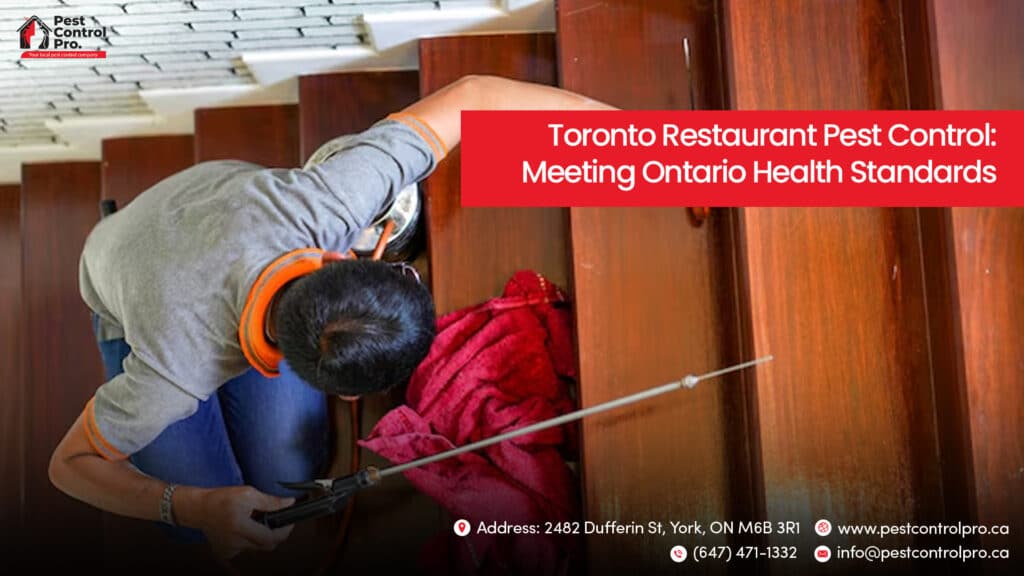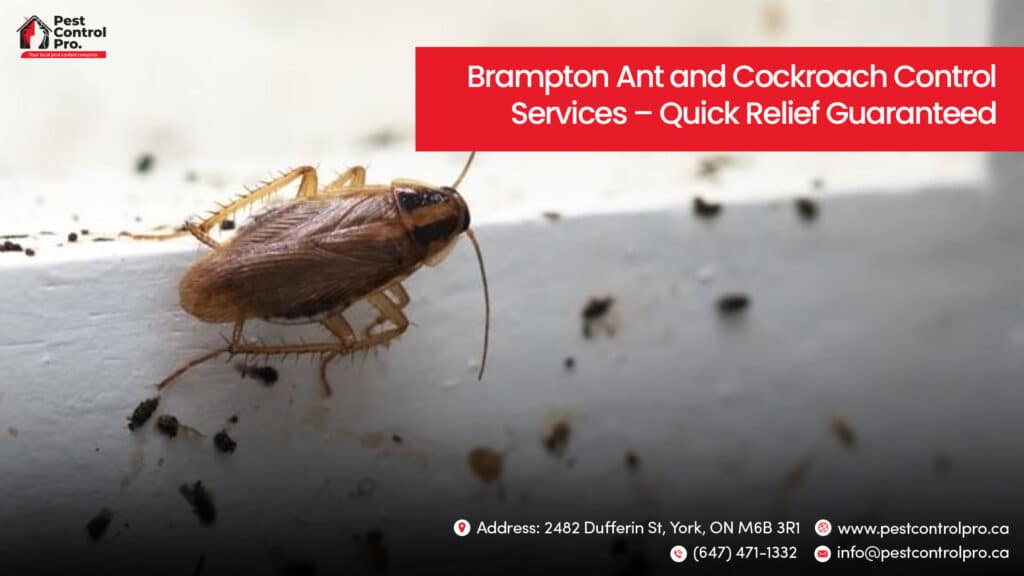Effective pest control is essential for Toronto restaurant owners striving to meet Ontario health standards. It ensures food safety and protects your customers’ well-being. Common pests like cockroaches, mice, and rats can jeopardize your establishment. To combat these issues, you should implement integrated pest management (IPM) strategies.
Collaborating with professional pest control services ensures compliance with health regulations and fosters a clean, safe dining environment. A well-maintained space not only enhances your reputation but also elevates safety standards. Did you know that a single cockroach can produce up to 300 eggs in its lifetime? This fact underscores the importance of proactive pest management.
By understanding and applying effective pest control practices, you can significantly improve your restaurant’s safety and appeal. Let’s delve into ways to further bolster your pest control efforts and keep your establishment thriving.
Importance of Pest Control in Food Premises
Pest control is crucial for any food establishment. It safeguards food safety and protects public health. In Ontario, every food premise must follow the Ontario Food Premises Regulation, which requires a solid pest control plan. Ignoring pest activity can lead to food contamination, health risks, and even outbreaks of illnesses, which can have legal consequences.
To tackle this, you should consult a licensed pest control operator. They can help you create a comprehensive strategy that addresses how pests enter and where they might hide. A well-developed pest management plan not only fulfills health regulations but also ensures a clean and safe environment for your staff and customers.
This commitment to cleanliness enhances your reputation in the food service industry. Did you know that a single cockroach can carry over 30 different pathogens? This highlights the importance of effective pest control in protecting your business and the health of your patrons.
Always prioritize pest management; it’s an investment in excellence and safety.
Common Pests Found in Restaurants
Restaurants often encounter pests that threaten food safety and hygiene. Cockroaches, rodents, and fruit flies are common offenders that can disrupt your establishment.
Cockroaches prefer warm, damp areas and reproduce quickly. Their presence can lead to serious food contamination issues.
Rodents, such as house mice and rats, can squeeze through small openings, causing infestations that compromise sanitation.
Fruit flies are typically drawn to overripe produce and indicate unsanitary conditions, which can also lead to food contamination if not promptly addressed.
Did you know that a female cockroach can produce up to 400 offspring in her lifetime? This statistic highlights the urgency of pest control in your restaurant.
To maintain a clean and safe environment, it’s crucial to implement a proactive pest management strategy.
Integrated Pest Management Strategies
To effectively tackle pest issues in your restaurant, adopting Integrated Pest Management (IPM) is essential. IPM combines prevention, monitoring, and control to maintain a pest-free environment.
Start by conducting regular inspections to spot signs of pests, like droppings or nests, and identify potential entry points, such as cracks and gaps.
Next, focus on sanitation. Eliminate food and water sources that attract pests by keeping food contact surfaces clean and ensuring food storage areas are tidy. Remember, even a small crumb can invite unwanted guests!
Utilize monitoring tools like glue boards and bait stations to keep track of pest activity. This will help you evaluate your control measures effectively.
By implementing IPM, you’ll not only comply with food safety standards set by Toronto Public Health but also ensure the safety of your patrons and the reputation of your business.
Did you know that a single cockroach can produce up to 30,000 offspring in a year? Keeping your restaurant pest-free is crucial for both your customers and your bottom line.
Embrace IPM, and take a proactive stance against pests today!
Compliance With Ontario Food Premises Regulation
To ensure a safe food environment, you must have a pest control plan that meets the Ontario Food Premises Regulation. This regulation is vital for protecting your establishment from pests and avoiding food contamination.
Here’s what you need to do:
- Conduct regular inspections. Keep an eye out for any signs of pest activity.
- Eliminate conditions that attract pests. This might involve proper waste disposal or sealing entry points.
- Consult a licensed pest control operator who can provide effective integrated pest management strategies.
Remember, non-compliance can lead to serious consequences like foodborne illnesses and fines from health authorities.
By following these steps, you not only uphold food safety but also protect your customers and your business.
Did you know that a single cockroach can carry over 30 different types of bacteria? Taking pest control seriously is crucial for maintaining a healthy environment.
Role of Professional Pest Control Services
Keeping your food establishment pest-free goes beyond just following the Ontario Food Premises Regulation.
Hiring professional pest control services is crucial for crafting a pest management plan that fits your specific needs. Expert pest control technicians conduct detailed inspections to evaluate the level of infestation and pinpoint access points, all while ensuring compliance with food safety regulations.
Did you know that a single cockroach can carry up to 33 different kinds of bacteria? This highlights the importance of taking immediate action against pests.
Monitoring and Documentation Practices
To maintain a pest-free restaurant, you must prioritize effective monitoring and documentation practices. These practices ensure compliance with Ontario health regulations and bolster food safety.
Start with regular monitoring of pest activity. This proactive approach allows you to detect issues early and respond quickly to infestations. Keep an eye out for signs of pests like droppings or gnawed materials.
Next, make documentation a priority. Keep detailed records of any pest sightings, control measures taken, and the effectiveness of treatments. This documentation is essential for being prepared for inspections from local health authorities.
Finally, maintain a pest control logbook. This logbook should detail the frequency of pest activity and the success rate of your control strategies over time. It’s a valuable tool for tracking patterns and improving your pest management efforts.
Did you know that regular pest inspections can reduce the likelihood of infestations by up to 80%?
Ensuring a Clean and Safe Environment for Food Safety
A clean and safe environment is crucial for ensuring food safety. It impacts both your customers’ health and your restaurant’s reputation. To maintain this, you must follow Ontario Food Premises Regulations. These regulations require a solid pest control plan to prevent pests from contaminating your food.
Regular inspections for pest signs are key. These checks help you stay in line with health standards. It’s also important to keep food contact surfaces and equipment sanitized. This practice significantly reduces the appeal for pests.
By using integrated pest management techniques—such as sealing entry points and maintaining cleanliness—you create a pest-free space. This not only supports safe food handling but also safeguards your guests’ well-being.
Frequently Asked Questions
How Do I Report a Restaurant in Toronto?
To report a restaurant in Toronto, contact Toronto Public Health. Reporting helps ensure food safety and proper health inspections. By detailing sanitation practices and pest issues, you contribute to better dining experiences.
Did you know that poor hygiene can lead to foodborne illnesses? As a pest control pro, it’s crucial to keep an eye on pest management. If you see signs of pests or unsanitary conditions, don’t hesitate to speak up. Your observations can make a difference for all diners.
What Is Step #1 on the 8 Steps to Passing Inspections From Toronto Public Health?
Step #1 on the 8 Steps to Passing Inspections from Toronto Public Health focuses on effective pest management. You must ensure that your facility complies with all health regulations, maintains high sanitation practices, and prioritizes food safety. This means taking specific actions to control rodents and other pests, which is vital for upholding your cleanliness standards. Did you know that a single mouse can produce up to 125 droppings a day? Keeping pests at bay is not just about cleanliness; it’s about protecting your reputation and health. So, take proactive measures today to safeguard your establishment from pest-related issues.
What Is the Best Way to Prevent Pest Infestation for Food Handlers?
To effectively prevent pest infestations as a food handler, you should focus on five key strategies:
- Implement Sanitation Practices: Regularly clean and sanitize all surfaces, equipment, and storage areas. This includes removing food debris and spills promptly, as they attract pests.
- Ensure Proper Food Storage: Store food in airtight containers and keep it elevated off the ground. This not only protects food from pests but also maintains its quality.
- Establish Pest Monitoring Systems: Use traps and monitoring devices to identify pest activity early. Regularly check these systems to stay ahead of potential infestations.
- Conduct Regular Maintenance Checks: Inspect your facility for cracks, crevices, and potential entry points. Seal these areas to prevent pests from finding their way inside.
- Invest in Employee Training: Train your staff on the importance of pest control. Teach them to recognize signs of infestations and the steps to take if they find any.
Additionally, forming partnerships with pest control professionals can provide you with ongoing support and expertise. Did you know that cockroaches can survive without food for a month? Keeping your environment clean and controlled is crucial to avoiding such resilient pests. Remember, a proactive approach is your best defense against infestations.



